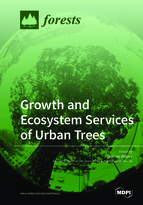Growth and Ecosystem Services of Urban Trees
A special issue of Forests (ISSN 1999-4907). This special issue belongs to the section "Forest Inventory, Modeling and Remote Sensing".
Deadline for manuscript submissions: closed (30 June 2019) | Viewed by 65965
Special Issue Editor
Interests: urban forestry; climate change; ecosystem modelling
Special Issues, Collections and Topics in MDPI journals
Special Issue Information
Dear Colleagues,
The studies of Kauppi et al. (2014), Fang et al. (2014), and Pretzsch et al. (2014) indicate an accelerated growth of forest trees, induced by ongoing climate change. Similar trends were recently found for urban trees in major cities worldwide.
Numerous studies can be found that demonstrate the substantial effects of climate change and the urban heat island effect (UHI) on plant growth. The combining effects of increasing temperatures, changed precipitation patterns, and extended growing season lengths in addition with increasing N-deposition and higher CO2 concentrations can increase but also reduce plant growth. Closely related to this, the multiple functions and services provided by urban trees may be modified.
Urban trees generate numerous ecosystem services, including carbon storage, mitigation of the heat island effect, reduction of rainwater runoff, pollutant filtering, recreation effects, shading, and cooling. Those ecosystem services are often closely associated with the species, structure, age and size of the tree as well as with a tree’s vitality. Therefore, greening cities and particularly planting trees seem to be an effective option to mitigate climate change and the UHI.
The focus of this Special Issue is to underline the importance of trees as part of the urban green for major cities in all climate zones. We encourage topics on empirical as well as on modelling studies of urban tree growth and their services and disservices in cities worldwide. Submissions on subjects concerning the magnitudes, patterns and the processes of microclimatic regulation through urban trees are welcome. Topics for manuscripts may further include:
Dynamics, structure and functions of urban tree growth,
Influence of climate and climate change on urban tree growth, urban species composition, carbon storage, and biodiversity,
Ways to improve the quality of life, conservation of biodiversity, adaptation and mitigation to climate change in major cities by urban trees
Quantifying urban tree growth, ecosystem services and disservices in major city worldwide.
Dr. Thomas Rötzer
Guest Editor
Manuscript Submission Information
Manuscripts should be submitted online at www.mdpi.com by registering and logging in to this website. Once you are registered, click here to go to the submission form. Manuscripts can be submitted until the deadline. All submissions that pass pre-check are peer-reviewed. Accepted papers will be published continuously in the journal (as soon as accepted) and will be listed together on the special issue website. Research articles, review articles as well as short communications are invited. For planned papers, a title and short abstract (about 100 words) can be sent to the Editorial Office for announcement on this website.
Submitted manuscripts should not have been published previously, nor be under consideration for publication elsewhere (except conference proceedings papers). All manuscripts are thoroughly refereed through a single-blind peer-review process. A guide for authors and other relevant information for submission of manuscripts is available on the Instructions for Authors page. Forests is an international peer-reviewed open access monthly journal published by MDPI.
Please visit the Instructions for Authors page before submitting a manuscript. The Article Processing Charge (APC) for publication in this open access journal is 2600 CHF (Swiss Francs). Submitted papers should be well formatted and use good English. Authors may use MDPI's English editing service prior to publication or during author revisions.
Keywords
- urban tree growth
- ecosystem services
- urban heat island effect
- climate change
- biodiversity
- carbon storage
- evapotranspirational cooling
- pollutants






